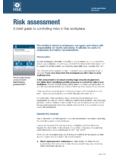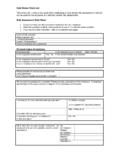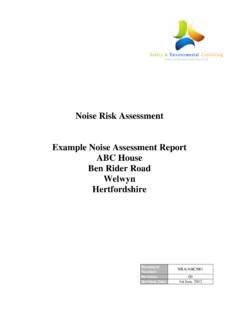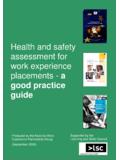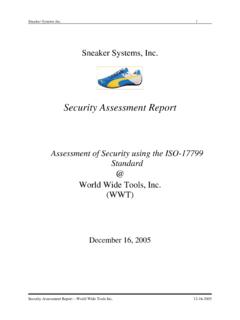Transcription of Hazardous Substance Risk Assessment Guide for …
1 Funded by Department of Employment and IndustrialRelations, Workplace Health andSafety QueenslandOffice of Education and EmploymentHazardous SubstanceRisk Assessment Guide for the CompositesIndustry Risk Assessment GuideHazardous Substance Risk Assessments .. 3 Hazardous Substance Risk Assessment Guide .. 6 Appendix A: Risk Assessment Template .. 17 Appendix B: Chemical Register .. 23 Specific Risk Assessment Forms:nPolyester Resin and Gel Coats .. 27nMethyl Ethyl Ketone Peroxides (MEKP) .. 31nGlass & Carbon Fibre (Mat, Fabric, Continous Strand Rovings) .. 35nAcetone .. 39nFillers .. 43nCobalt 6% .. 47nDMA (N,N-dimethylanaline) .. 51nEpoxy Resin Part A .. 55nEpoxy Resin Part B .. 59nPolyamine-Based Hardeners .. 63nPolyurethane Resins .. 67nPolyurethane Curing Agents .. 71nMould Release Agents.
2 75 IndexQueensland legislationnWorkplace Health and Safety Regulation 1997 Part 13 Hazardous SubstancesnWorkplace Health and Safety Code of Practice Risk Management 2007nWorkplace Health and Safety Code of Practice Hazardous Substances 2003nDangerous Goods Safety Management Regulation 2001 Australian Standards/New Zealand StandardsnAS/NZS 4360:2004 - Risk management nHB 436:2004 - Risk management guidelines Companion to AS/NZS 4360:2004nAS 1319:1994 - Safety signs for the occupational environment Material Safety Data Sheets (MSDS) for various booklet has been produced through funding by the Queensland Government Department of Employment and Industrial Relations and in collaboration withComposites Australia. References2 Risk Assessment GuideQueensland Workplace Health and Safety legislation requiresthat the risks from using a Hazardous Substance at work beassessed.
3 A record of this Assessment be made and kept and communicated to all personnel using the Substance . A Hazardous Substance risk Assessment is a process of applying information aboutthe Substance to the way that it is used. The risk Assessment will help you work outif the Substance is being used safely, and if not how to use it safely. The benefits of preparing a written Hazardous Substance risk Assessment are to:nProvide the obligation holder with all details of chemicals used at the workplacenSet the framework on information and training for workersnEstablish systems of worknCreate a safe environment in which to Guide has been designed for the Composites Industry to provide: nA step-by-step approach on how to do Hazardous Substance risk assessmentsnA risk Assessment template (Appendix A). The supplement to this Guide Generic Hazardous Substance Risk Assessments provides example risk assessments on many Hazardous substances used in thecomposites industry to assist operators in that industry.
4 These risk assessments aregeneric only. Circumstances are different in every workshop therefore your riskassessments may be significantly different. A register listing all Hazardous substances must be kept in the workplace. A form for this purpose is also included (Appendix B).Note: There may be Hazardous substances used at your workplace that are notincluded in the Substance Risk Assessments 3 Risk Assessment GuideCurrent Hazardous substances used in the workplace:Do a risk Assessment :nNow, if a risk Assessment has not yet been done nWhen there are significant changesto the way in which the Substance is usednWhen new informationabout the Substance becomes available (refer to changes in the Material Safety Data Sheet MSDS) nWhen health surveillance or monitoring shows the control measures are inadequatenWhen there are changesto control measures nIf it is more than 5 yearsafter the last risk Assessment was done for Hazardous substances introduced to the workplace:nBefore usingthe to do a HazardousSubstance Risk Assessment .
5 Before starting on your Hazardous Substance risk assessments, you will need:nA current (less than 5 years old)Material Safety Data Sheet (MSDS) for eachhazardous Substance used at your workplace. If you don t have an MSDS ask the supplier for a copy nThe job taskswhere this Substance is used. This should include: How it is used. It may be necessary to do multiple risk Assessment for the one Substance if it is used in different ways and the exposures vary. For example, one risk Assessment may be needed for mixing a substanceand one for applying the Substance How much is used How often it is usednInformation on any safety controlscurrently used in the workplace. This may be: Engineering controls such as ventilation or dust extraction systems Personal Protective Equipment (PPE)nRecorded informationon any injuries or illnesses caused by use of thesubstance.
6 This may be from your workplace or other workplaces using the substancenInformation on like or similar products. It is possible to group substances that are similar in their ingredients and how they are used. Therefore one risk Assessment may cover a number of it is essential to carefully check the MSDS for each Substance to ensureall potential exposures and ingredients are covered in the risk Supplement to this Guide provides risk assessments for generic products used within the composites industry. Information for the specific substances used in your workplace will need to be used for any risk Assessment doing yourHazardous Substance Risk Assessment : 4 Risk Assessment GuideThe generic risk assessments are:nPolyester Resin and Gel CoatsnMethyl Ethyl Ketone Peroxides (MEKP)nGlass and Carbon Fibre (Mat, Fabric, Continuous Strand Rovings)nAcetonenFillersnCobalt 6%nDMA (N,N-dimethylanaline)nEpoxy Resin Part AnEpoxy Resin Part BnPolyamine-Based HardenersnPolyurethane ResinsnPolyurethane Curing AgentsnMould Release AgentsnTo check the MSDS for Hazardous Substance classification.
7 Check the MSDS for wording like Hazardous according to the criteria of NOHSC . If the Substance is not classified as Hazardous it can still haveeffects on the health of people using it. The obligation on an employer to ensure the health and safety of employees are protected still you will still need to assess and control the observewhat is actually done. A risk Assessment cannot be done by sitting at a desk. You will need to observe employees completing tasks and activities to collect sufficientinformation to complete a risk Assessment . This may need to be done in doing yourHazardous Substance Risk Assessment (Cont): Using the risk Assessment form attached to this Guide (see appendix A) is one way of keeping a suitable Hazardous Substance risk Assessment record. However you can make your own record if you prefer (refer to the WorkplaceHealth and Safety Regulation for what must be recorded and for further details onthe risk Assessment record).
8 The following guidance is provided to assist in completing the risk Assessment form attached to this Guide . How to do a HazardousSubstance RiskAssessment: 5 Risk Assessment GuideInsert the name of the Hazardous you are grouping a number of substances, write the group name here and refer to an attachment where each Substance is you are doing more than one risk Assessment for the one Substance , : one for mixing and one for application, you may refer to this in the name. For example, Mixing Epoxy Resin Part A. You should also record the name of any related risk assessments to the one you are may also select the relevant dangerous goods symbols and insert it below the name of the Substance . Name of SubstanceDescribe the task in which the Substance is the Substance is used for a number of different tasks a risk Assessment may be needed for each a brief statement on how the Substance or group of substances is used by you must observe what your employees actually do with the How is the substanceused?
9 6 Hazardous Substance Risk Assessments ExampleExampleName of Substance :Related Risk Assessments:Epoxy Resin Part AABC Marine CompanyEpoxy Resin Part B1. How is the Substance used? describe the task? (If the chemical is used for a numberof different tasks a risk Assessment may be needed for each task).Mixed with Epoxy Resin Part B and then sprayed or brushed onto finished Name:Business Name:(Insert the name of your business here)ExampleRisk Assessment Guide7 Tick or mark the applicable routes of entry on exposure. Refer also to the are four ways (routes of exposure) a Hazardous Substance can enter a person s body:Skin absorbed through the skin and affects other parts of the body or can affectthe skin directly. The Substance may be splashed straight onto the skin or ontoclothes and then soaks through to the skin. The skin may come into contact with the Substance through vapours, mists, fumes or dusts This is the same as for skin.
10 That is via splashes, vapours, fumes, mists ordusts. The Substance may affect the eyes directly or can be absorbed the most problematic route of entry. This can be via vapours, mists,fumes or dusts etc which are breathed in and either do damage where they hit a surface in the respiratory system or are absorbed by the body and cause health the least common type of exposure and is caused by swallowing the How are peopleexposed to thesubstance?Example2. How are people exposed tothe Substance ?(Tick or mark applicable routes ofentry)Skin (splashed onto or absorbed through)3 Eyes (splashed onto or absorbed through)3 Inhalation (breathed in)3 Ingestion (swallowed)3 Record the actual amounts : millilitres, milligrams, kilograms or grams, several tasks being performed and record the amounts to whichemployees are How much of thesubstance are workersexposed to during thetask?

